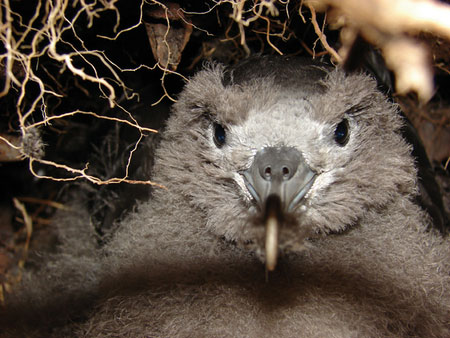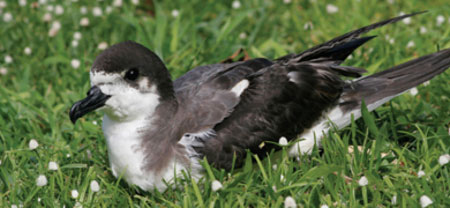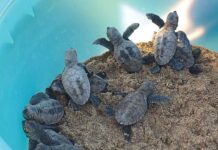Shannon Waianecki | Photos by Kim & Forest Starr
 Zooming through the darkness, the Hawaiian petrels return from sea. Their weird and wonderful music fills the night sky above Lana‘ihale, Lana‘i’s tallest peak. Yips and squeals erupt against the forest’s black outline as the sooty grey birds tunnel into thick stands of uluhe fern to find their underground nests. Inside each burrow, a hungry fluff ball of a chick waits to be fed.
Zooming through the darkness, the Hawaiian petrels return from sea. Their weird and wonderful music fills the night sky above Lana‘ihale, Lana‘i’s tallest peak. Yips and squeals erupt against the forest’s black outline as the sooty grey birds tunnel into thick stands of uluhe fern to find their underground nests. Inside each burrow, a hungry fluff ball of a chick waits to be fed.
Those acquainted with these strange and marvelous birds know them from the remote, frigid summits of Haleakala on Maui and Mauna Kea on the Island of Hawai‘i, where they use their claws and beaks to burrow into volcanic rock. But fossils show that the rare seabirds once covered the Hawaiian Islands, from summit to sea. Large flocks of acrobatic petrels likely assisted early voyagers in finding Hawai‘i. The Hawaiians named them ‘ua‘u, mimicking their puppy-like calls. ‘Ua‘u chicks, fattened with squid and fish, were a delicacy reserved for Hawaiian royals.
 Unfortunately, ground-nesting birds don’t mix well with burgeoning human populations. While ‘ua‘u are whizzes at sea, swooping, arcing, and flying over forty miles per hour, they’re clumsy on land. During the spring breeding season, parents take turns incubating a single egg and then caring for their helpless chick hidden underground. Juvenile birds can take up to 120 days to fledge. The family’s primary defense is invisibility—a strategy that likely worked well before the introduction of four-legged predators. Dogs, cats, and mongooses can easily find and scoop birds from their burrows; a single cat can decimate a colony in a night.
Unfortunately, ground-nesting birds don’t mix well with burgeoning human populations. While ‘ua‘u are whizzes at sea, swooping, arcing, and flying over forty miles per hour, they’re clumsy on land. During the spring breeding season, parents take turns incubating a single egg and then caring for their helpless chick hidden underground. Juvenile birds can take up to 120 days to fledge. The family’s primary defense is invisibility—a strategy that likely worked well before the introduction of four-legged predators. Dogs, cats, and mongooses can easily find and scoop birds from their burrows; a single cat can decimate a colony in a night.
Urban lighting poses additional hazards for the nocturnal birds. Disoriented by bright lights, petrels end up stranded, often injured, on hotel grounds and ship decks. By 1967, predation and habitat loss had earned the ‘ua‘u one of the first spots on the Endangered Species List.
Just two exits lead from endangered status: extinction and recovery. Recovery begins with biologists’ solid understanding of the species’ habits and whereabouts. Thus far, ‘ua‘u have proven mysterious. The pelagic birds spend the majority of their lives at sea. While counts at sea estimate a total ‘ua‘u population of 19,000, only around 1,500 birds nest at the summit of Haleakala, the state’s largest known colony. Where do the others nest? What pressures might they be encountering? Without this information, helping the ‘ua‘u escape extinction—the fate of so many Hawaiian birds—would be a near impossible task.
Enter Dr. Fern Duvall, the wildlife biologist for the Department of Land and Natural Resources (DLNR), and Jay Penniman, a researcher with the University of Hawai‘i Pacific Cooperative Studies Unit. These friends and fellow ornithologists are bent on helping the ‘ua‘u through the door to long-term survival.
Duvall has rescued countless stranded seabirds and testified before committees to reduce unnecessary urban lighting. Each spring, he gives public talks on best practices for protecting nesting seabirds. When Duvall consults the state’s Comprehensive Wildlife Conservation Strategy—an encyclopedic tome of Hawaiian bird info, he’s reading entries he wrote. His cell phone is even programmed with birdsong recorded in the field. (When Penniman rings Duvall, a shearwater squawks to announce it.) The clever ring tones are apt—when Duvall’s phone rings, it’s likely an injured bird needs his attention.
Penniman has similar feathers in his cap. Before moving to Hawai‘i, he censused and monitored seabirds on the Farallon Islands, the largest seabird colony in the continental United States. Ornithological books and artwork decorate Penniman’s home on Maui—including a lovely rendering of an ‘ua‘u by Duvall. Recently Penniman adopted an injured ‘ua‘u chick, hand-feeding the feisty, feathered toddler until its successful fledging. (This was a substantial commitment, considering that not only do ‘ua‘u typically take four months to fledge, they also emit a strong, musky smell.)
Certainly, if anybody deserves to be associated with what Penniman called in The Maui News “one of the remarkable discoveries of the century,” it’s these two.
That discovery took shape in 2006, when Duvall and Penniman followed up on a hunch that ‘ua‘u might be nesting on Lana‘i. Years earlier, while surveying for rare plants in Lana‘i’s cloud forest, Duvall stumbled across an ‘ua‘u that had recently been killed by a cat. In addition, a longtime Lana‘i resident had mapped sites where he had seen and heard petrels. Based on this evidence, Duvall and Penniman assembled a survey team along the four-wheel-drive road leading up to Lana‘ihale.
They waited as night fell. Sure enough, they soon heard yaps and squeals overhead. Only, instead of the dozen or so birds the scientists expected, the pitch-black sky filled with the sounds of more birds than the team could count. The discovery was thrilling. No one in the birding community imagined that so many birds would be found; overnight, the known breeding sites for the species had grown substantially.
Once the researchers located the ‘ua‘u nests, they could establish protocols to safeguard them. In cooperation with the landowner, Castle and Cook, they got to work monitoring burrows, constructing fences, and setting predator traps. Duvall surmises that the absence of mongooses and the limited streetlights on Lana‘i factor into the colony’s success.
Fortuitously, Penniman learned that his Farallon Islands colleague David Ainley, of the ecological consulting firm HT Harvey & Associates, had teamed up with the U.S. Geological Survey’s Josh Adams, and that the two had new funding to track Hawaiian petrels on Haleakala using satellite telemetry. Ainley and Adams agreed to lend some of their equipment to Penniman and Duvall on Lana‘i. As the projects merged, the ‘ua‘u team gained additional support from Joy Tamayose and Cathleen Bailey from Haleakala National Park, and Holly Freifeld from the U.S. Fish and Wildlife Service.
Looking back, Duvall laughs, “No one checked the astrology, but I think the planets were aligned.”
The ‘ua‘u project may have gotten a lucky break, but that didn’t make the work any easier. First the researchers had to locate burrows large enough to accommodate a bird wearing its transmitter. After inspecting more than 100 burrows, the team selected four birds, two on Haleakala and two on Lana‘i, fitted them with transmitters, and awaited their return.
“We would wait for days,” says Duvall, “For whatever reason, the bird will fly right over land, even right over the burrow, and not alight. It’s a really strenuous thing to stay up on the wet, cold mountain for several nights.”
Their efforts were rewarded with another fascinating discovery. Ornithologists had previously assumed that the petrels stayed nearby while foraging for their chick. Instead, the transmitters recorded bleeps from as far as the northern Gulf of Alaska.
“The literature said that these birds probably go 1,000 kilometers out to forage. The satellite tells us they travel up to 10,000 kilometers,” says Penniman. Nine more petrels tagged in 2007 showed the same flight pattern.
Hawaiian petrels fly far and fast—up to seventy kilometers, or forty-three miles, per hour. Pretty impressive for a bird with a three-foot wingspan! During two-week foraging trips, these Pacific voyagers spend only 4 percent of their time resting on the water. Why they fly so far remains unknown; it’s possible that commercial overfishing has compelled them to look further and further for suitable food.
Meanwhile, back at the burrow, Penniman and Duvall recognized that the new colony on Lana‘i needed someone to look after it. Lana‘i resident Christine Costales joined the team as a DLNR endangered species field assistant. Like Duvall and Penniman, Costales fell for the charismatic charm of the ‘ua‘u, spending long hours on Lana‘ihale listening for birds and checking traps. She even admits to sniffing feathers she finds on the trailside, hoping that their telltale scent will lead her to the elusive petrel. For her dedication, Duvall christened her with a nickname borrowed from a native fern: wahine noho mauna, or “the woman who stays on the mountain.”
This January, Costales came down from the mountain to coordinate public outreach and recruit volunteers. Community support will be essential in helping Lana‘i’s fledgling ‘ua‘u preservation effort take wing. Plus, there are still Hawaiian petrel mysteries to be solved, for instance: exactly how do the birds find their way across such vast stretches of sea?
Don’t be surprised if the call of the ‘ua‘u lures you to sacrifice a good night’s sleep—it seems to have that effect on people.




